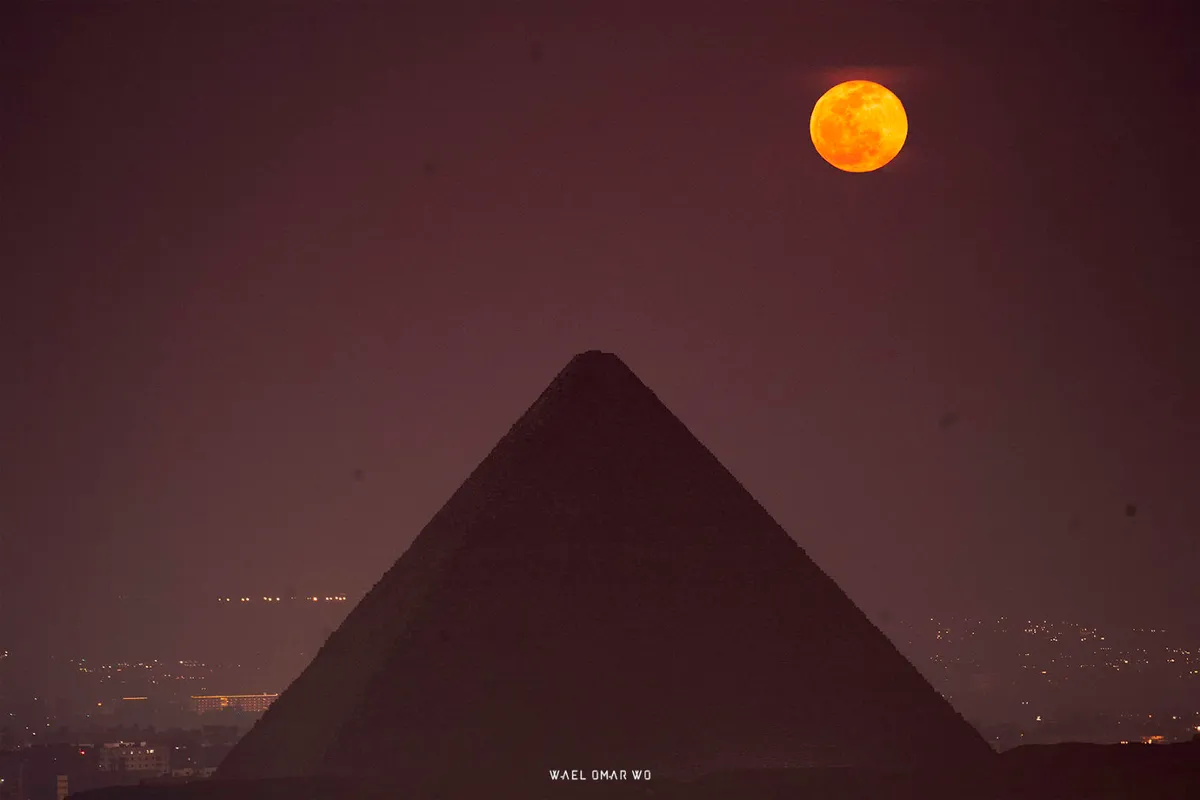Solstices (meaning ‘the Sun standing still’) mark the two longest days of the year – 20 or 21 June in the Northern Hemisphere, 21 or 22 December in the Southern Hemisphere – when the Sun is furthest north or south of the equator and highest in the sky at midday.
Celebrated by cultures on either side of the equator for thousands of years, a summer solstice is when that hemisphere is tilted towards the Sun, a by-product of Earth’s rotational axis being tilted by 23.4˚.
As well as being an important marker of Earth’s journey around the Sun, the summer solstice has real-world consequences, marking a period of the most sunlight in a day and, therefore, heat: astronomical summer.

Here are 12 fascinating ancient places in both hemispheres that align with the solstice, each with a unique story and cultural significance.
World-famous or less well-known, all offer a glimpse into the rich history of humanity’s relationship with the Sun and the sky.
1 - Stonehenge, Wiltshire, UK

Stonehenge is perhaps the world’s most famous monument that, seemingly, aligns with the rising Sun on the date of the summer solstice.
The stone circle is thought to have been built around 2500 BC, but the exact purpose of this amazing structure is unknown.
It may have been a burial site, a calendar or an astronomical observatory.
What is known is that on the date of the summer solstice, the Sun rises just to the left of the Heel Stone, a single block of sarsen stone standing outside the circle’s entrance.
It may have had another stone beside it, framing the solstice sunrise.
About 8,000 people attend the solstice sunrise each year.
It’s free to get in, but English Heritage also livestreams the magical moment online.
2 - Chaco Canyon, New Mexico, USA

Chaco Culture National Historical Park in northwest New Mexico was the centre of the ancestral Puebloan culture from AD 100 to 1600.
It features cliff dwellings, multi-storey buildings and kivas.
Casa Rinconada, a sunken circular ‘great house’, is aligned with the cardinal directions.
Fajada Butte has a rock where a dagger-shaped beam of sunlight appears on spiral-shaped petroglyphs during the solstice.
A boulder known as the Rock of the Sun is also thought to feature a solstice alignment.
The centre of a spiral petroglyph on the rock’s eastern side is pierced by a triangular shadow about two weeks before the June solstice.
During this time, the Sun sets in a niche on the western side of Chaco Canyon.
3 - Ballochroy, Kintyre, UK

Ballochroy may have been one of the earliest megalithic observatories, but that’s an increasingly controversial theory.
Three stones standing 2, 3 and 3.5 metres tall (6.5, 9.8 and 11.5ft), arranged northeast to southwest, align with where the Sun would have set on the evening of the summer solstice about 3,500 years ago, behind a mountain on the island of Jura to the northwest.
If that indicates that it was an observatory capable of determining the date of the solstice, it’s also a theory challenged by archeologists who discovered a cairn that would have obstructed the alignment
But the Sun setting behind Jura in mid-to-late June remains a wondrous sight from this iconic megalithic monument.
It’s free to visit: park on the A83, 18km (11 miles) south of Tarbert and ascend the stone track.
4 - Hovenweep National Monument, Utah, USA

In a vast and mostly empty region of southeastern Utah, Hovenweep National Monument is an International Dark Sky Park on the Colorado–Utah border.
At the main structure, 13th-century Hovenweep Castle, there are ports and a door that appear to have shone sunlight on a solar calendar on the inside wall of one room.
At sunrise on the summer solstice, a spot of light shines through a small opening and illuminates a specific place on the back wall.
This projection of light is present every morning, effectively tracing out a solar calendar.
At a more remote site called Holly House, two concentric-circle petroglyphs are pierced by shafts of light (‘sun daggers’) as the Sun rises on the summer solstice.
Hovenweep is open year-round and its campsite is fabulous for stargazing.
5 - Bighorn Medicine Wheel, Wyoming, USA

Medicine wheels consist of two concentric circles of stones with lines radiating from the centre, often aligned with the cardinal points.
These sacred structures hold ceremonial and spiritual significance for Native American people.
Approximately 150 medicine wheels have been discovered on both sides of the US–Canada border, the best-preserved one being the Bighorn Medicine Wheel in the Bighorn National Forest, Wyoming
Estimated to be between a few hundred and 3,000 years old, it features five cairns outside a wheel and one inside on the northwest side, all made of limestone.
The wheel marks the summer solstice sunrise between two cairns and the sunset behind the inside cairn.
It is open to visitors from mid-June until mid-September, and the round trip walk from the road is about 4.8km (3 miles).
6 - La Table des Marchands, Carnac, France

The Carnac stones are a dense array of megalithic sites spread across an area of northwestern France, close to Brittany’s south coast.
They feature over 3,000 prehistoric standing stones, dolmens (tombs) and tumuli (mounds).
Dating back as far as 4500 BC (at least 1,000 years before the construction of Stonehenge), many of the stone arrangements hint at solar significance.
At one complex, southeast in Locmariaquer, are three monuments – Le Grand Menhir Brisé, Er Grah tumulus and La Table des Marchands (‘merchants’ table’) – the latter being a passage tomb with an enormous 40-tonne capstone.
The passage inside La Table des Marchands is aligned to the solstice, with its sandstone endstone illuminated by the midsummer sunlight.
The site has variable opening hours and the entrance fee is €7.
7 - Piedras Blancas, Antequera, Spain

Only discovered in 2023, this rectangular megalithic tomb, which is about 5,000 years old, is carved into bedrock.
Piedras Blancas is lined with stone slabs, and specially selected and carved slabs mark an east entrance and a west chamber.
The slabs appear to have been arranged purposefully, because the solstice sunrise illuminates engraved walls within the chamber.
Meanwhile, an arrow-shaped stone on the chamber floor points towards the rising Sun.
Piedras Blancas is beneath a prominent mountain called La Peña de los Enamorados (Lovers’ Rock) – itself aligned with the Dolmen of Menga, one of the largest and oldest megalithic structures in Europe – within the World Heritage Site of Antequera, known for its abundant natural rock formations and megalithic monuments.
The tomb is located just off the A-92 motorway between Granada and Antequera.
8 - Casa Grande Ruins National Monument, Arizona, USA

Casa Grande, meaning ‘great house’, is a four-storey mud structure 80km (50 miles) southeast of Phoenix.
Constructed around AD 1350, it features a small room at the top with walls perfectly aligned to the cardinal points.
During the summer solstice, the setting Sun aligns with a circular hole in the upper west wall, while twin openings align with the rising Sun during the spring and autumn equinox.
This has led to the theory that Casa Grande may have served as an astronomical observatory, and certainly as some kind of ceremonial site.
It is believed to have been built at the epicentre of a farming community by the ancestral Sonoran Desert people of the Hohokam culture.
The site is open every day from 9am to 4pm.
9 - Pyramids of Giza, Egypt

Wael Omar, Giza, Egypt, 6 April 2023
Equipment: Canon EOS 200D DSLR camera, 18-55mm lens (wide image); Sony A7 III mirrorless camera (close shots)
Khufu’s Great Pyramid of Giza, built about 4,500 years ago, is aligned with the cardinal directions with impressive accuracy, better than four arcminutes, or one-fifteenth of a degree.
The Great Sphinx of Giza, located to the east and facing east, also has notable alignments.
For example, during the summer solstice, standing to the east of the Sphinx at sunset reveals the Sun setting between the silhouettes of the pyramids of Khufu and Khafre.
However, the alignments seen at the spring and autumn equinox are thought to be more significant.
On these days, the Sun sets on the shoulder of the Sphinx.
Recently, scientists have argued that the east–west shadows that fall on the equinox at sunrise and sunset may have been used to align the three pyramids at Giza.
10 - Angkor Wat, Cambodia

to the Sun’s movements
throughout the year. Credit: Wirestock / Getty Images
Angkor Wat is the world’s most renowned Hindu-Buddhist temple complex, covering over 400 square kilometres (150 square miles).
Originally built in the early 12th century as a Hindu temple for the Khmer empire, it was later converted into a Buddhist temple.
Solstice alignments seem to have played an important part in the temple design.
Unlike neighbouring temples that face east, Angkor Wat’s gate faces west, and crowds gather to witness the sunrise over the central tower during the spring equinox.
On the summer solstice, the Sun rises over the northern ceremonial entrance from the western end of the bridge over the moat.
From the western entrance, it rises over the northeastern corner tower of the complex.
The summer solstice sunrise is also believed to align with a small temple atop the prominent hill of Phnom Bok, about 16km (10 miles) away.
A one-day Angkor Pass costs $37 and the main temple is open from 5am for sunrise viewing.
11 - Machu Picchu, Peru

through the window of the Temple of the Sun during the winter solstice. Credit: Westend61 / Getty Images
Constructed around AD 1450 and abandoned within a century, Machu Picchu was a sacred site for Inca leaders, who claimed descent from Inti, the sun god.
Academics have suggested several solstice alignment theories over the years, some more convincing than others.
At sunrise on the winter solstice in June, a stone altar within the Temple of the Sun is illuminated thanks to a northeast-facing window, leading some to speculate that it was built as an astronomical observatory.
Underneath is the royal mausoleum, a natural cave oriented to the sunrise on the winter solstice.
Elsewhere is the Intimachay, an adapted natural cave illuminated only during the 20 days around the summer solstice in December.
Tickets to the site cost $42 and must be reserved in advance online.
12 - Chichén Itzá, Mexico

Chichén Itzá, one of the largest Mayan cities built between AD 600 and 1200, is 105km (65 miles) east of Mérida, the capital of Yucatán.
At the centre of the complex is the nine-storey, 30-metre-tall (98ft) Kukulcán pyramid, which has a double-storey temple on top, accessible via steep staircases on each side.
The pyramid has four staircases, each of 91 steps. Add the top step at the summit and that totals 365.
At sunset on the summer solstice, the light casts a perfect shadow on the south and west sides, making it appear to split in two.
During sunsets of both equinoxes, a serpent-like shadow descends the pyramid’s stairs, a phenomenon known as ‘the descent of Kukulcán’ (the name refers to a feathered serpent god).
Chichén Itzá is open from 8am to 5pm, and entry costs M$614.
What are your favourite monuments that align with the solstice? Have you captured any images? Get in touch via contactus@skyatnightmagazine.com.
This guide appeared in the June 2024 issue of BBC Sky at Night Magazine

